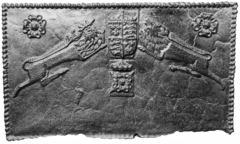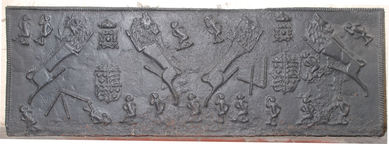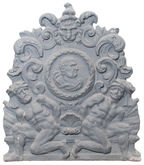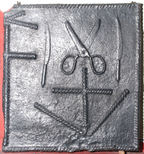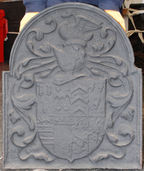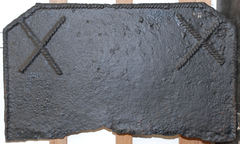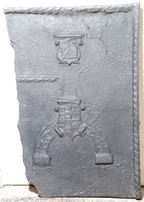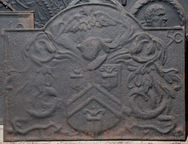-
450
Description: Rectangular; twisted rope edging; central crowned Tudor shield with lion passant guardant sinister to the left, and lion passant to right; four-petalled rose in right and left corners; crowned, barbed, four-petalled rose below shield.
Notes: One of a large series bearing some or all of the same stamps.
Arms: Tudor royal arms of England
- Decoration tags:
- rectangular (shape)
- rope (edging)
- carved stamps
- heraldic
- armorial
- animals
Manufactured: in the mid-16th century in the Weald area of England.
Current location: Barbican House, High Street, Lewes, East Sussex, England.
Museum number: LH000.800 (part of the Sussex Archaeological Society museum group)
Citation: Dawson, C., 1903, 'Sussex Iron Work and Pottery', Sussex Archaeological Collections, 46, pp. 1-54.
- Attached to series:
- Royal series
-
451
Description: Rectangular; twisted rope edging (top and sides); basic arrangement of crowned Tudor rose above a crowned Tudor royal shield, all between a crowned lion passant guardant sinister and lion passant, both per bend, repeated on both halves of the plate; irregularly arranged, mainly along the top and bottom, are sixteen small figures, alternately with right arm raised or lowered; bottom left and centre right are two different arrangements of a length of twisted rope in 'V' and 'I'.
Notes: The stamps used on this large fireback are encountered on several firebacks indicating their common source; previously at Legh Manor, Cuckfield, Sussex.
Arms: Tudor royal arms of England
- Decoration tags:
- rectangular (shape)
- rope (edging)
- simple stamps
- carved stamps
- heraldic
- apotropaic
- armorial
- animals
- humans
- objects
Manufactured: in the mid-16th century in the Weald area of England.
Current location: Anne of Cleves House, Southover High Street, Lewes, East Sussex, England.
Museum number: LH000.937 (part of the Sussex Archaeological Society museum group)
- Attached to series:
- Royal series
-
452
Description: Circular wreathed medallion, bearing the right-facing head of a man in classical dress, carried by two naked, kneeling male figures seated on an elongated pedestal, between them a scallop shell; above the medallion a lion’s face surmounted by a flame; the medallion is surrounded by floral scrolls.
Notes: The wooden pattern would have had a circular aperture (the frame of which is just discernible) for the reception of the medallion; the same pattern was used to cast a fireback bearing the arms of George Worge, and the stamp of the profile was used on an accompanying fireplace side plate (no. 923).
- Decoration tags:
- baroque (shape)
- complex individual (edging)
- whole carved pattern
- pictorial
- humans
Manufactured: in the early- to mid-18th century probably at Robertsbridge Furnace, Salehurst in the Weald area of England.
Current location: Anne of Cleves House, Southover High Street, Lewes, East Sussex, England.
Museum number: LH000.998 (part of the Sussex Archaeological Society museum group)
Citation: Dawson, C., 1903, 'Sussex Iron Work and Pottery', Sussex Archaeological Collections, 46, pp. 1-54.
- Attached to series:
- Baroque series
-
453
Description: Rectangular; twisted rope edging; irregular arrangement of three rope lengths at top left; rope cross above ‘V’ at middle bottom; impression of a pair of scissors between two impressions of a domestic table knife.
Notes: The knife is early-17th century in date or perhaps a bit earlier, just into Elizabeth I’s reign. The pommels date them from around this time and the long and narrow blades are right for the end of Elizabeth/early James I. The irregular rope lengths suggest this is probably part of a larger fireback.
- Decoration tags:
- rectangular (shape)
- rope (edging)
- simple stamps
- apotropaic
- objects
Manufactured: in the late-16th to early-17th century in the Weald area of England.
Current location: Anne of Cleves House, Southover High Street, Lewes, East Sussex, England.
Museum number: LH000.939 (part of the Sussex Archaeological Society museum group)
Citation: Moore, S., 1999, Cutlery for the Table (Sheffield, The Hallamshire Press).
-
454
Description: Arched rectangular shape; rebated fillet edging; shield, helm, crest and mantling of the family of Barttelot of Stopham, Sussex.
Notes: The shield is divided into eight quarters (from left) top: Barttelot, Stopham, Lewknor, Doyley; bottom: Tregoz, Camoys, Walton and Sykeston; arms granted in this form in 1616. Walter Bartlett/Barttelot ran Pallingham furnace in the early 17th century, suggesting a possible place of manufacture.
Copies of this fireback are known.
Arms: Barttelot of Stopham
- Decoration tags:
- rectangular with round arch (shape)
- rebated fillet (edging)
- whole carved pattern
- armorial
Manufactured: in the early-17th century possibly at Pallingham Furnace, Wisborough Green in the Weald area of England.
Current location: Hall Place, Bexley, Kent, England.
Museum number: 1931.21.005 (part of the Sussex Archaeological Society museum group)
- Attached to series:
- Personal armorial firebacks
-
455
Description: Canted rectangle; twisted rope edging (top and sides); a rope saltire in each top corner.
Notes: The edging is made from the same, short lengths of rope as the saltires.
- Decoration tags:
- rectangular with canted top corners (shape)
- rope (edging)
- simple stamps
- apotropaic
- objects
Manufactured: in the 16th century in the Weald area of England.
Current location: Hall Place, Bexley, Kent, England.
Museum number: 1944.24.049 (part of the Sussex Archaeological Society museum group)
- Attached to series:
- Rope design firebacks
-
456
Description: Arched rectangular shaped central panel with canted, concave top corners and bead edging; figure seated astride a triumph of weaponry (cannon, spears, drums), holding a laurel wreath in his right hand, symmetrical hanging drapery above; same-shaped border with fillet edging and suspended ribbons with floral bunches; at base, symmetrical reeds tied with ribbon; base panel with nine linked rings; symmetrical serpents on top.
Notes: Possibly a depiction of an allegory of Victory. Other firebacks have the same distinctive central panel, border shape and decoration at the bottom, suggesting the same pattern maker. A reduced version (no. 1253) lacks the serpents on top and the reeds at the bottom. Formerly part of the J. H. Every collection.
- Decoration tags:
- 'Dutch' (shape)
- fillet (edging)
- whole carved pattern
- pictorial
- mythological
- humans
- objects
Manufactured: in the late-17th to early-18th century possibly in the Weald area of England.
Current location: Anne of Cleves House, Southover High Street, Lewes, East Sussex, England.
Museum number: 1944.24.079 (part of the Sussex Archaeological Society museum group)
- Attached to series:
- Mayfield 'Dutch' series
- British 'Dutch' style firebacks
-
457
Description: Fragment; right part, prob. rectangular; twisted strip edging (top and sides); stamp of firedog with semi-circular feet, and with shields at top and bottom of shaft, the lower with quartered arms, the upper with diagonal bar over a rectangle (gate?); horizontal twisted strip length to left of firedog.
Notes: The twisted lengths clearly show the flattened form of a strip of material (poss. leather).
- Decoration tags:
- rectangular (shape)
- twisted leather (edging)
- simple stamps
- objects
Manufactured: in the 16th century in the Weald area of England.
Current location: Anne of Cleves House, Southover High Street, Lewes, East Sussex, England.
Museum number: LH000.914 (part of the Sussex Archaeological Society museum group)
- Attached to series:
- Firedog stamp firebacks
- Metalware stamp firebacks
-
458
Description: Fragment; bottom left corner missing; rectangular; ovolo-moulded edging; initials split by date across top of plate.
Notes: The numerals show the transition between archaic and modern type styles. Formerly part of the J. H. Every collection.
Inscription: S 1753 W
- Decoration tags:
- rectangular (shape)
- ovolo (edging)
- individual letters
- individual numbers
- text
Manufactured: in 1753 in the Weald area of England.
Current location: Anne of Cleves House, Southover High Street, Lewes, East Sussex, England.
Museum number: LH000.922 (part of the Sussex Archaeological Society museum group)
- Attached to series:
- Date & initials firebacks
-
459
Description: Arched rectangular shape; fillet edging; shield, helm, crest and mantling of the Worshipful Company of Blacksmiths; date in top corners; initials at bottom, below mantling.
Notes: One of the hooked ‘1’ series; unevenly impressed, the right more deeply than the left.
Copies of this fireback are known.
Inscription: 16 50 / I M
Arms: Worshipful Company of Blacksmiths
- Decoration tags:
- rectangular with round arch (shape)
- fillet (edging)
- whole carved pattern
- armorial
- text
Manufactured: in 1650 possibly at Brede Furnace in the Weald area of England.
Current location: Anne of Cleves House, Southover High Street, Lewes, East Sussex, England.
Museum number: 1933.34.046 (part of the Sussex Archaeological Society museum group)
Citation: Dawson, C., 1903, 'Sussex Iron Work and Pottery', Sussex Archaeological Collections, 46, pp. 1-54.
Citation: Gardner, J. S., 1898, 'Iron Casting in the Weald', Archaeologia, 56, 1, pp. 133-164.
- Attached to series:
- Livery company firebacks
- Hooked '1' series
- Brede group
- IM series
